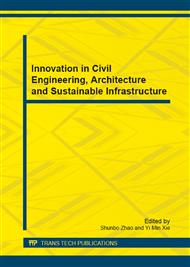p.617
p.621
p.625
p.631
p.635
p.640
p.643
p.648
p.652
Study on the Property of Ductility of T-Shaped Short-Shear Walls (II)
Abstract:
Based on the experimental study, this paper analyzes the strength and ductility of T-shaped short-shear walls and studies the measures to improve the ductility of specimens by adjusting its sectional reinforcement form. Using finite element software ABAQUS to simulate the elastic and plastic damage process of T-shaped short-shear walls after adjusting the sectional reinforcement, and then to analyze the force characteristic and ductility of the structural elements. The results indicate that under the premise of keeping the total quantities of sectional reinforcement basically constant, the proposed method can effectively improve the ductility of T-shaped short-shear walls while the webs are compressed and the reinforcement form is reasonable.
Info:
Periodical:
Pages:
635-639
Citation:
Online since:
November 2012
Authors:
Price:
Сopyright:
© 2012 Trans Tech Publications Ltd. All Rights Reserved
Share:
Citation:


